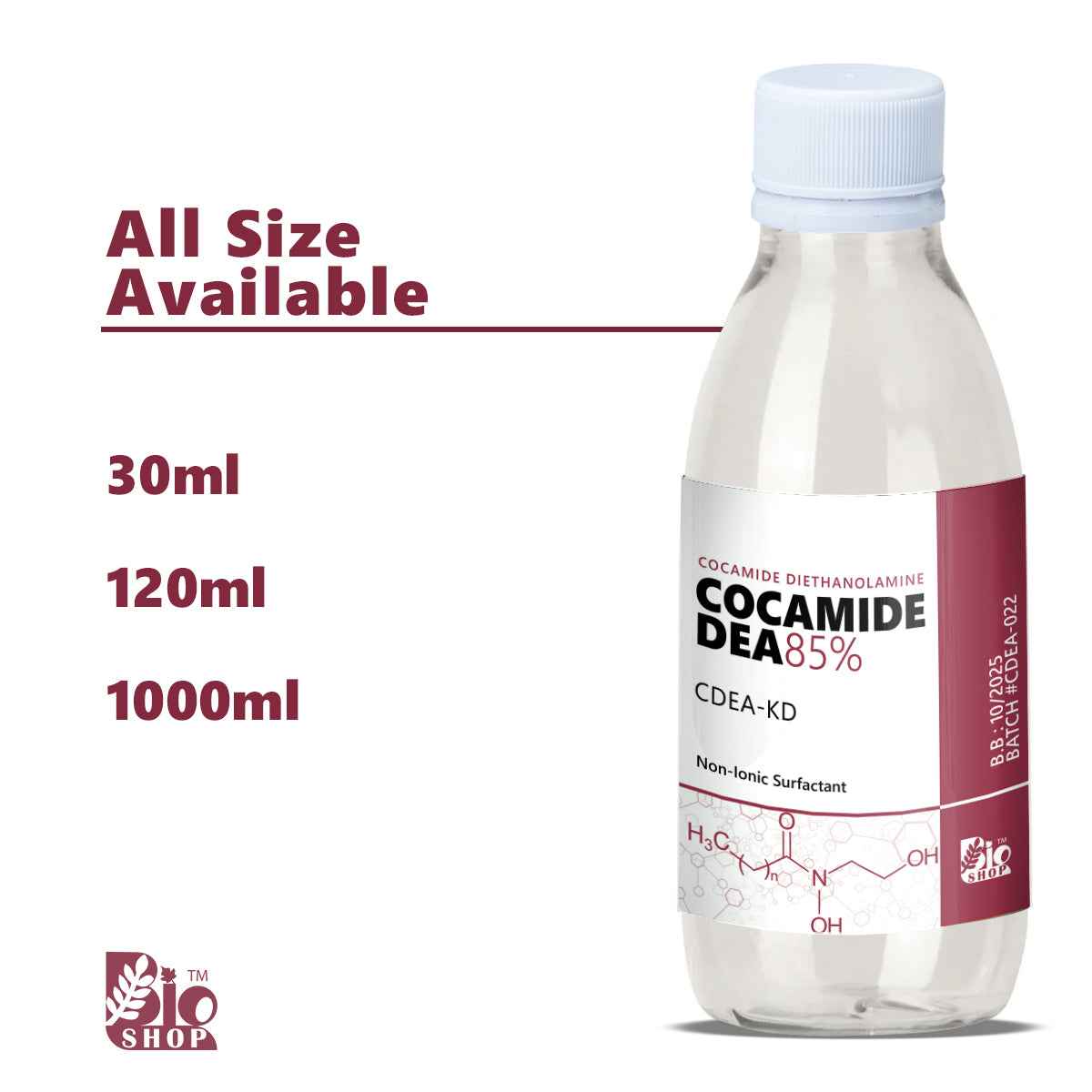Bio Shop
Cocamide DEA (Diethanolamine)
Cocamide DEA (Diethanolamine)
Key Functions: Enhances foam quality, increases viscosity, and improves cleansing efficacy in surfactant-based formulations.
Pickup available at A. Rehman
Usually ready in 24 hours
Explore
Information About Cocamide DEA (Diethanolamine)
✅ Key Features
- Acts as a foam booster and thickener
- Improves texture and stability in surfactant blends
- Compatible with SLES, SLS, and other anionic surfactants
- Used in shampoos, hand washes, body washes, and liquid soaps
- Easy to blend at room temperature
🔬 Description
Cocamide DEA – Foam Booster & Thickener for Shampoos, Soaps & Cleansers
Cocamide DEA (Diethanolamine) is a non-ionic surfactant derived from coconut oil and diethanolamine. It is primarily used in personal care formulations to enhance lather, increase viscosity, and provide a smooth texture to cleansing products. Commonly found in commercial shampoos, body washes, and hand soaps, Cocamide DEA is highly effective at stabilizing foam and thickening formulations without altering the cleansing action. Although highly functional, it should be used within regulatory guidelines due to safety considerations in some countries.
📊 Technical Data
INCI Name: Cocamide DEA
CAS Number: 68603-42-9
Solubility: Water-soluble
Add Phase: Heated water phase
pH Stability: 5.0 – 8.0
Processing Temperature: 45–60°C
Appearance: Amber to golden viscous liquid
Odor: Mild fatty odor
Molecular Formula: RCON(CH₂CH₂OH)₂ (variable chain length)
Molecular Weight: Variable (~280–310 g/mol)
Flash Point: > 200°C
Density: ~1.0 g/cm³
Chemical Type: Nonionic surfactant
Functional Groups: Amide, hydroxyl
Primary Cosmetic Uses: Shampoo, liquid soap, face washes, bubble baths
🧪 Recommended Usage
- Usage Rate: 1% – 10%
- Recommended Additions: Used with SLES/SLS for thickening and stabilizing foam
- Storage: Store tightly closed in a cool, dry place
💡 Pro Tip
To achieve better lather and thickness in your shampoo formulations, combine Cocamide DEA with SLES and a pinch of salt (Sodium Chloride). For sensitive formulations, consider using alternatives like Cocamidopropyl Betaine or PEG-free thickeners.
👩🔬 Skin Type Compatibility
✔️ Oily
✔️ Normal
✔️ Combination
❌ Not suitable for sensitive skin or baby care without further safety evaluation
🧴 Formulation Ideas
1. Thickened Herbal Shampoo
70% SLES Shampoo Base
4% Cocamide DEA
2% Polyquaternium-10
1.5% Fragrance Oil
0.5% Preservative
2% Herbal Extract (Amla, Neem, Aloe Vera)
2. Adjust viscosity with 1% Salt
Foaming Hand Wash
60% Water
10% SLES
5% Cocamide DEA
1% Glycerin
0.5% Essential Oil
0.5% Preservative
0.5% Citric Acid (pH adjust)
💧 Cosmetic Suitability:
Serums
☆☆☆☆☆ – Not Applicable
🟥⬜⬜⬜⬜
Creams & Lotions
☆☆☆☆☆ – Not Suitable
🟥⬜⬜⬜⬜
Toners
☆☆☆☆☆ – Not Suitable
🟥⬜⬜⬜⬜
Face Masks
☆☆☆☆☆ – Not Suitable
🟥⬜⬜⬜⬜
Cleansers
⭐⭐⭐⭐☆ – Good
🟩🟩🟩🟩⬜
Hair Masks
☆☆☆☆☆ – Not Applicable
🟥⬜⬜⬜⬜
Deodorants
☆☆☆☆☆ – Not Suitable
🟥⬜⬜⬜⬜
Eye Creams
☆☆☆☆☆ – Not Suitable
🟥⬜⬜⬜⬜
Shampoos
⭐⭐⭐⭐☆ – Good
🟩🟩🟩🟩⬜
Soaps
⭐⭐⭐⭐☆ – Good
🟩🟩🟩🟩⬜
Conditioners
☆☆☆☆☆ – Not Suitable
🟥⬜⬜⬜⬜
Lip Balms
☆☆☆☆☆ – Not Suitable
🟥⬜⬜⬜⬜
Body Butters
☆☆☆☆☆ – Not Suitable
🟥⬜⬜⬜⬜
Ointments
☆☆☆☆☆ – Not Suitable
🟥⬜⬜⬜⬜
❓ FAQs
Q1: Is Cocamide DEA safe for use in cosmetics?
It is allowed in rinse-off products in many regions, but banned in some countries. Always check regulatory compliance before use.
Q2: Can I use Cocamide DEA in sulfate-free shampoos?
No. It works best with SLES or SLS systems and is not suited for sulfate-free formulas.
Q3: Does it help thicken shampoos?
Yes, Cocamide DEA enhances viscosity and makes the formula feel richer.
📂 Documentation
Upon request, we will provide.
Where Can You Safely Use Cocamide DEA (Diethanolamine)
Discover how Cocamide DEA (Diethanolamine) performs across different products — rated for safety, stability, and effectiveness.








